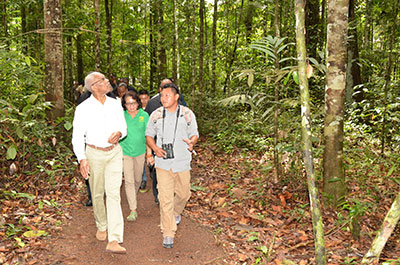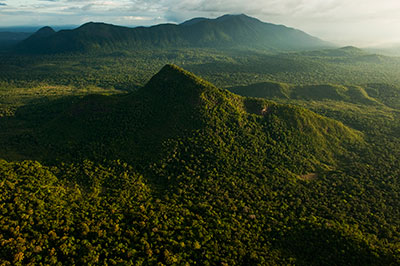–Promoting Sustainable Development
THE global fight against the adverse effects of Climate Change is one which requires urgent

action and a concerted effort to secure the world’s future.
Guyana continues to be a reliable partner in the fight against Climate Change, pressing ahead steadfastly to the goal of becoming a ‘Green’ State.
This policy position — combined with the fact that Guyana has one of the highest proportions of forest cover of any country in the world, and the ability to absorb more carbon dioxide than it emits — means that the country is well positioned to access climate financing for its renewable energy goals.
Sustainable development has been the goal of the international community since the UN Conference on Environment and Development (UNCED) in 1992. The concept of a ‘Green’ Economy later served as a major theme for the 2012 UN Conference on Sustainable Development in Brazil (Rio+20).

In 2015, countries within the United Nations adopted the Sustainable Development Goals as a means of ending poverty, protecting the planet, and ensuring prosperity for all. Internationally, the development of ‘Green’ Economies is seen as a means toward fostering international cooperation for support in the area of sustainable development.
A NEW THRUST
Since his assumption to office in May 2015, President David Granger has placed Guyana more squarely on a path towards the sustainable exploitation of resources, and the protection and proper management of the environment.
In his address at the 71st Session of the UN General Assembly on September 20 in New York, the president highlighted Guyana’s commitment to the development of a ‘Green’ State.
Deeming Guyana to be part of the global ‘green’ movement, the president said that the country’s natural assets, commitment to sustainable development, contribution to countering the adverse effects of Climate Change and collaboration with the international community in seeking solutions to global threats have distinguished it as an “emergent ‘green’ state”.
“Guyana promises to continue to work towards the Agenda’s goals, particularly by contributing to limiting increases in global temperatures, and working towards a ‘green path’ of development that is in accord with the Agreement’s nationally-determined commitments,” the president said.
PARIS AGREEMENT
A major step for Guyana was the signing, along with 196 other countries, of the Paris Agreement in April 2016 in New York. The Agreement had been adopted at the 21st UN Framework on Climate Change Conference of Parties (COP21) in Paris, and is seen as the most ambitious global response to tackling the threat of Climate Change.
At the Commemoration Concert for the Ratification of the Paris Agreement on Climate Change, hosted by the European Union on December 6 in Guyana, President Granger reiterated Guyana’s commitment to being part of the solution, and said that it plays a big role in mitigating the effects of greenhouse gas emissions.
“Guyana will devote an additional two million hectares of its forests to conservation, as part of the global thrust to arrest Climate Change,” the president said. “Guyana is pursuing a low-carbon, low-emission, ‘green’ trajectory of economic development; Guyana will become a ‘green’ State. Cooperation with Guyana is a global good,” he added.
But more than pledging commitment, the president has been active in the promotion of Guyana’s ‘green’ agenda. It is with this goal in mind that Guyana has been pursuing further bilateral partnerships.
MARRAKESH MEETING
Recently, the president attended the Joint High Level Segment (HLS) of the Twenty-second Conference of Parties (COP22) in Marrakech, Kingdom of Morocco. His attendance was at the invitation from the King of Morocco, His Majesty Mohammed VI.
There, he expressed Guyana’s intention to honour its obligations under the Paris Agreement, through the development and implementation of a comprehensive Emissions Reduction Programme. The Head of State also supported the call for increased climate financing, particularly for adaptation, and based on vulnerabilities of countries and not their economies measured by their Gross Domestic Product (GDP).
The president was accompanied by a team of officials, who all play a pivotal role in the advancement of Guyana’s ‘Green’ Agenda. Guyana cannot on its own fund the cost of its ambitious action plan, but it can, through partnerships, exchange the value of standing forests for support for the development of ‘green’ energy.
The delegation’s presence in Marrakesh augured well for the country, as it invited the opportunity for several high level meetings to be held in the promotion of global partnerships in the fight against climate change.
With over 22,000 participants attending the event, Head of the recently established Department of the Environment, Ms. Ndibi Schwiers said that the setting up of meetings was a strategic process, where engagements were sought with stakeholders who were considered to have shared interests with regard to Guyana’s ’green’ agenda.
FRAMEWORK DEVELOPMENT
Guyana is now also working with the United Nations Environment Programme (UNEP) to develop a Framework for the ‘green’ State development strategy.
The delivery of this Framework falls within the responsibility of the Project Management Office, and Head of the Office, Mr. Marlon Bristol said that the document is expected to be completed by January 2017.
The construction of the document will take a two-pronged approach, and will seek to involve the views and input of a wide cross-section of stakeholders.
“As part of the development of that strategy, not only will UNEP start the process, because they have the global template that can be localised,” Bristol said, adding:
“And they have been putting in some financial and technical support to get this done… The document is meant to be a very comprehensive document that will look into all the sectors and the supportive sectors.
“So, the ‘Green’ State Development Strategy is basically the strategy that takes us forward to the ‘green’ State.”
COUNTRY-DRIVEN
Ms. Schwiers emphasised that the Framework is a country-driven document, which will have the buy-in of citizens of the country as consultations will be held in all 10 of the country’s Administative Regions. “I think it’s easy for people to think that because we are involving international consultants, that there will not be ownership… [but] it is a country-driven process, driven by local technicians. The emphasis is now on the ‘green’ agenda for the country.
“This agenda is what will be used nationally to align the country to the 2030 Sustainable Development Goals, so that this whole ‘green’ State plan can be a plan for 15 years so it will be a big plan,” Schwiers said.
But the road towards becoming a ‘green’ State would be incomplete without the involvement of the Office of Climate Change.
Established in 2009 primarily to support the implementation of the Low-Carbon Development Strategy (LCDS), the Office’s main role now includes the development and coordination of key Government ‘green’ State policies with regard to Climate Change adaptation, mitigation, resilience building, and also general education and awareness.
Head of the OCC, Ms. Janelle Christian stated that the aim of a ‘green’ State moves beyond the provisions of the LCDS and includes a wider scope.
“I believe the LCDS has given us the building blocks where the focus really with respect to mitigation was largely on the forest sector. We want to go beyond that; having a holistic approach to our development. And so, that is where we’re seeking to go with the ‘green’ development strategy in keeping with the principles of inclusivity; in keeping with the principles of sustainable utilisation of our resources and natural capital; and in keeping with the principles of sustainable development,” she said.
WORK OF THE OCC
In this regard, the work of the OCC has seen quite a packed schedule of initiatives in an effort to fulfil its mandate. These include several projects which are receiving support from international partners such as the United Nations Development Programme (UNDP), the Inter-American Development Bank (IDB) and other partners in order to realise the policies and initiatives that President Granger has expressed as priority.
“And when we talk about ‘green’ economy,” Christian said, “we are looking at ensuring that whatever comes out of that Framework will address Guyana’s climate vulnerability; increasing our resilience; ensuring that we have transformative Climate Change adaptation projects that we have transformative, renewable energy projects when we talk about mitigation. Also, taking into consideration our biological diversity, taking into consideration also the sustainable development goals, which have to be taken into consideration in any future planning and those discussions and decisions and efforts have already started both at the Office of Climate Change and with our international partners.”
It is the work of these and other agencies falling under the authority of the Department of Environment that construct a streamlined approach toward the president’s vision.
TRANSITION
While these changes are occurring at a higher level, the transition towards a ‘green’ State; what can be a case study and flagship of this policy is what is happening in Bartica, Cuyuni-Mazaruni.
President Granger has called for the development of ‘green’ municipal towns, and designated Bartica as the flagship for this thrust. As a result, the transformation of Bartica into a ‘green’ town is underway, and the town is also high on the agenda of the OCC.
More than that, the president believes that the ‘green’ transformation cannot be achieved without the participation of the citizens and the private sector; and following calls on society to join the movement, progress has been seen in these areas as well.
In late November, Demerara Bank Limited (DBL) launched its solar-powered Head Office on Camp Street, and President Granger lauded the company for leading the charge toward transitioning to clean energy.
DBL Chief Executive Officer, Mr. Pravinchandra Dave said that based on calculations, the cost for solar electricity lies within the reach of members of the private sector and even private citizens.
Provisions have also been made in the 2017 Budget, with an allocation of almost $1B to implement a series of renewable energy and energy efficiency projects.
These projects include the installation of the first ever solar farm in Mabaruma. Additional solar farms are also hoped to be established in other locations such as Bartica, Lethem and Mahdia.
The government will also be granting a one-off tax holiday of two years for corporation tax to importers of items for wind and solar energy investments, and for investors in water treatment, waste disposal, and recycling facilities.
And with the Department of the Environment currently exploring all renewable energy options as an outcome of President Granger’s meeting with Minister of Climate and Environment, Mr Vidar Helgesen of the Kingdom of Norway on the sidelines of COP22 for the creation of a work plan for detailing Guyana’s clean energy transition, the Head of State is keen on encouraging renewable energy buy-in by members of the private sector and private citizens.
Not only is renewable energy the clean option, it is the cheaper option and can see a reduced energy cost, which is a main driver for the manufacturing sector.
A ‘green’ State holds a bright future for Guyana; one where every Guyanese can benefit from clean, affordable renewable energy, where the country’s patrimony is protected, where Guyanese can enjoy a clean and pristine environment and where ‘green’ economic advancement will foster the good life.




.jpg)









